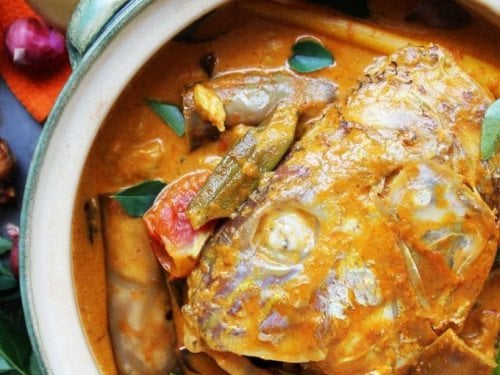jaundiceinnewborns.net – Fish head curry is a dish that boldly showcases the vibrant flavors of South Indian cuisine, adapted and embraced in Southeast Asia, particularly in Singapore and Malaysia. As the name suggests, the dish features a fish head as the centerpiece, simmered in a rich and tangy curry along with a medley of vegetables and aromatic spices. It’s a culinary adventure that challenges conventional notions of food presentation and delivers a complex and deeply satisfying flavor experience.
A Culinary Crossroads: The Origins and Evolution of Fish Head Curry
While curry is deeply rooted in Indian culinary traditions, the specific concept of using a fish head as the main ingredient is believed to be a unique adaptation that emerged in Southeast Asia. It’s thought that Indian immigrants, particularly those from South India, brought their curry-making techniques to the region, where they encountered a plentiful supply of fresh seafood. The fish head, often considered a less desirable part of the fish in some cultures, was embraced for its rich flavor and gelatinous texture, becoming the star of this now-iconic dish.
The dish likely evolved in the multicultural melting pot of Singapore and Malaysia, influenced by Chinese and Malay culinary practices. This fusion of flavors and techniques resulted in the distinctive Fish Head Curry we know today.
The Essence of Fish Head Curry: A Symphony of Flavors and Textures
The magic of Fish Head Curry lies in the harmonious blend of spicy, tangy, and savory flavors, complemented by the varied textures of the fish and vegetables.
- The Fish Head: The type of fish head used can vary, but snapper, redfish, and grouper are common choices. The head is typically cut in half and thoroughly cleaned before being added to the curry. The fish head provides a rich, gelatinous texture and imparts a deep flavor to the curry. The cheeks and the area around the eyes are considered particularly flavorful.
- The Curry: The curry is a complex concoction of spices, including chili peppers, coriander, cumin, turmeric, fenugreek, and mustard seeds. These spices are often tempered in hot oil before being added to the curry, releasing their aromatic oils. Tomatoes, onions, and ginger are also essential components of the curry base. Tamarind pulp or juice is often added for a tangy flavor.
- The Vegetables: A variety of vegetables are typically included in Fish Head Curry, such as okra (ladies’ fingers), eggplants (brinjals), and tomatoes. These vegetables add texture and absorb the flavorful curry.
A Culinary Experience: Embracing the Unique
Eating Fish Head Curry is an experience that engages all the senses. The vibrant colors of the curry, the aromatic spices, and the unique presentation of the fish head create a truly memorable dining experience.
- Serving and Eating: Fish Head Curry is typically served in a large pot or clay pot, allowing the flavors to meld together. It’s often accompanied by rice, papadums (thin, crispy lentil crackers), and sometimes other side dishes. Eating Fish Head Curry often involves using your hands to navigate the various parts of the fish head and to savor the flavorful curry.
- Regional Variations: While the core elements of Fish Head Curry remain consistent, there are regional variations. Some versions may be spicier or tangier than others, and different types of vegetables or fish may be used.
Fish Head Curry: A Bold Expression of Culinary Fusion
Fish Head Curry is more than just a dish; it’s a bold expression of culinary fusion, showcasing the rich cultural heritage of Southeast Asia. It’s a testament to the creativity and adaptability of cooks who have blended different culinary traditions to create something truly unique. While the presentation may be initially daunting for some, the complex and satisfying flavors of Fish Head Curry are sure to leave a lasting impression. It stands as a testament to the power of food to transcend cultural boundaries and create unforgettable culinary experiences.
